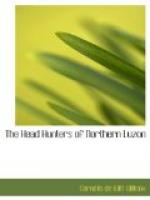It is pertinent to remark that the Ifugaos treat their women well; for example, the men do the heavy work, and there are no women cargadores. In fact, the sexes seemed to me to be on terms of perfect equality. The people in general appeared to be cheerful, good-humored, and hospitable. Mr. Worcester pointed out that whereas most of the men present were unarmed (at any rate, they had neither spears nor shields), in his early trips through this country, as elsewhere, every man came on fully armed, and the ground was stuck full of spears, each with its shield leaning on it, the owner near by with the rest of his rancheria, and all ready at a moment’s notice to kill and take heads. For although these people are all of the same blood and speak nearly the same language, still there is no tribal government; the people live in independent settlements (rancherias), all as recently as five or six years ago hostile to one another, and taking heads at every opportunity. This state of affairs was undoubtedly partly due to the almost complete lack of communication then prevailing, thus limiting the activities of each rancheria to the growing of food, varied by an effort to take as many heads as possible from the rancheria across the valley, without undue loss of its own. And what is said here of the Ifugao is true also of the Ilongot, the Igorot, the Kalinga, the Apayao, and of all the rest of the head-hunting highlanders of Northern Luzon. The results accomplished by Mr. Worcester with all these people simply exceed belief. But this subject, being worthy of more than passing mention, will be considered later. The afternoon is wearing on, and we must get at the two exceptions mentioned some little time ago.
Since these highlanders have but little meat to eat, it is the policy of the Government, on the occasion of these annual progresses, to furnish a few carabaos, so that some of the people, at least, while they are the guests of the Government, may have what they are fondest of and most infrequently get. And they have been until recently allowed to slaughter the carabao, according to their own custom, in competition, catch-as-catch-can, so to say. For the poor beast, tethered and eating grass all unconscious of its fate,




